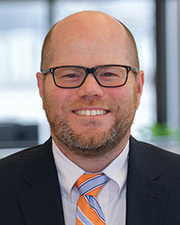
BSC Group
Return-to-work planning has property owners and managers scrambling to address wellness factors such as HVAC settings, seating configurations, personal protective equipment, and much more. These immediate actions will help us to respond to the threat of virus and contagion – but a true well workplace considers other, more permanent factors that can have lasting effects beyond the COVID-19 crisis.
BSC Group was excited to be part of EMD Serono’s design team for the expansion of its campus through the construction of the 30,000 s/f Sagamore Building on the biopharmaceutical firm’s 22-acre Billerica campus. From the very beginning, this project was visionary in seeking WELL certification from the International WELL Building Institute. This program applies a standard for building design that establishes best practices for air quality, light, nutrition, mental health, and materials selection. The Sagamore Building’s integrated design team of architects, engineers, and landscape architects was successful in completing the first WELL Certified Gold building in the United States and just the second in the entire world.
A variety of design elements contributed to the project’s certification, such as on-site fitness facilities, emphasis on natural light, adoption of nutrition standards, biophilic plantings, low VOC-emitting finishes and furniture, and the promotion of alternative transportation through bike racks and showers.
While WELL certification is not the goal of most property owners and managers, the COVID-19 pandemic has trained a spotlight on our office settings and how they can impact general health. It is our obligation to provide a healthy workplace that prioritizes employee wellness as strongly as productivity and efficiency. The research and technology applied to the WELL certification process can inform our transition to healthier workplaces through creative and well-planned retrofits that support overall wellness.
Innovation and pragmatism partner for common-sense solutions that can be implemented with wellness benefits that far exceed their costs. Some lessons that can be gleaned from EMD Serono’s successful project include:
Take it Outside: Interior spaces are fundamentally limited in the social distance they can provide, even at reduced occupancy levels. Creating welcoming, comfortable, and attractive outdoor meeting spaces can help to achieve social distancing and provide an inspiring change of scenery that sparks creativity. Walking trails and boardwalks can also be added to existing campuses to promote wellness through physical activity and create an attractive amenity for employees.
Bring the Outdoors In: Biophilic design brings plant materials indoors to improve air quality and create a connection to nature that has been proven to promote well-being. Beyond the typical potted plants, biophilic designs are bold statements about nature’s function and importance. To be effective, plantings should be abundant; landscape architects can recommend attractive, effective species and placements that deter pests and require limited maintenance.
Go Natural: The well corporate campus steers away from traditional, well-tended lawns, opting instead for naturalized landscapes that are beautiful and functional. In addition to creating an aesthetic campus setting, these biodiverse spaces become valuable habitat for a myriad of species, including fragile pollinators that are critical to our ecosystem. Additional benefits of this landscape approach are reduced maintenance costs associated with mowing, as well as discontinued use of pesticides and herbicides.
Implementing just some of these solutions can bring a variety of benefits to the workplace. Increased productivity and a healthier workforce are obvious advantages. EMD Serono has found that creating a healthy workplace for their employees is a natural offshoot of their overall mission to transform lives through wellness. In seeking to attract and retain the best talents in a highly competitive field, wellness is a key differentiator that gives them a recruitment edge.
The 2020 pandemic will have an enduring impact on how we prioritize health and wellness – as individuals, as employers, and as designers. Our response must extend beyond the immediate crisis to create a framework for healthier workplaces that meet the wellness needs of our colleagues and employees.
Taylor Dowdy, PE, civil engineering manager at BSC Group, Boston.








